CanBuild: Lessons from the Royal Society Summer Science Exhibition
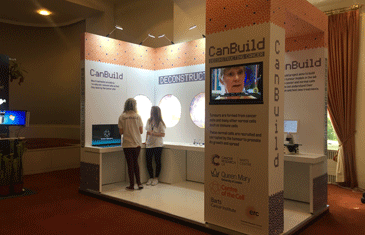
Written by Rebecca Knowlson and Alex Jenkin, Learning and Outreach Officers at Centre of the Cell, Queen Mary University of London
In July this year, scientists from Queen Mary University of London, Cancer Research UK (CRUK) and Centre of the Cell spent a week at the Royal Society Summer Science Exhibition, engaging the public with the work of Barts Cancer Institute’s (BCI) CanBuild project.
The Summer Science Exhibition is an annual event showcasing cutting-edge science from around the UK with a very competitive application process and it was privilege to attend with the CanBuild team.
The CanBuild project is exploring the tumour microenvironment. A tumour is made up of many cell types and the CanBuild team have been working for the last few years to determine the types and proportions of cells present. They are now beginning the second stage of the project, growing these cells together in a three dimensional environment with the aim of creating a living human tumour model in the lab.
The three key messages of the stand were:
- Tumours are formed from cancer cells and many other normal cells such as immune cells. These normal cells are recruited and corrupted by the tumour to promote its growth and spread.
- New treatments are able to ‘re-educate’ immune cells so that they destroy the cancer cells.
- The CanBuild project aims to build 3D human tumour models in the lab with both cancer and normal cells so that we can understand their interaction.
The stand aimed to communicate these messages through 3 main activities along with an introductory video and back-lit microscope images of the tumour microenvironment paired with illustrated images to show the different cell types.
Activities:
- Tumour Takedown - Developed with the CanBuild team at Barts Cancer Institute and Rebecca Knowlson at Centre of the Cell, Tumour Takedown takes the user through the different cells in the tumour microenvironment, allowing them to construct a tumour model. The game then progresses to the treatment stage where they can use three potential new treatments to destroy the tumour, targeting a range of different cells.
- Gel-making - This activity allowed visitors to create their own 3D gel balls, similar to those used in the lab to create a 3D environment for the tumour cells to grow in. Users were able to pipette one liquid into another to create the gels themselves.
- Microscope with cell samples - This gave visitors the opportunity to see real human cells grown in 2D and 3D environments, including some different cell types grown alongside each other.
These activities were designed to be used either as standalone activities or in conjunction with each other to explain the work the CanBuild team are doing.
Challenges of Exhibiting
One of the challenges we experienced running the stand at the exhibition is that you cannot know the background knowledge of each visitor. They could be someone who wandered into the exhibition not ever having heard of it before, a child on a school trip, someone with an interest in science, a PhD student or a Fellow of the Royal Society. This presents the problem: where to start your explanation?
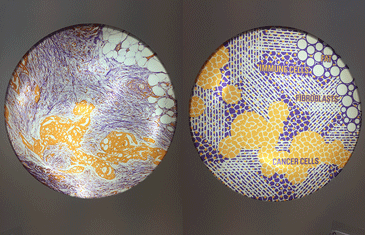
A backlit cell with explainations of what the coloured sections are
Our favoured solution quickly became asking each visitor the same question: “What do you understand about cancer?” This gave us an awareness of their knowledge and allowed us to pitch correctly. In fact, often the answer was very similar: “It’s mutated cells growing out of control.” From here we were able to use the images on the stand to talk about the other cells involved in the tumour microenvironment and consequently the work of the CanBuild team.
How to deal with lots of people visiting a stand
The Royal Society recorded 14,371 visitors during the week of the exhibition and from this we estimate that around 5,000 people visited our stand. The stand was continuously busy and as a result we very quickly had to develop techniques to deal with lots of visitors at once.
At any one time there were 3 to 4 volunteers working on the stand. We had originally planned to have one person per activity, however we soon discovered that this didn’t really work as it was too restrictive. We needed the flexibility to be able to move away from the activities and approach people who looked like they might be interested in the stand. This wasn’t too much of a problem as we discovered that the only section of the stand that needed staffing at all times was the microscope. We learnt from this that it’s a good idea before the event to think carefully about which activities absolutely need to be staffed at all times and which ones can be left for visitors to participate in by themselves.
We discovered that the main way to deal with lots of visitors at the stand was to make sure that you didn’t spend too much time with each visitor. It was important to be aware of how long you had spent talking to each visitor while keeping an awareness of your surroundings and how many other people were waiting to speak to you.
In addition, during quieter periods, we found that it was a good idea to move away from the stand to draw people in. However, we soon realised that only one or two of us could do this at the same time as you need to ensure that there’s always someone at the stand. It is easy to get caught out – you’re chatting to someone and then turn around to find the stand swarming with people and no staff!
Things we Learnt
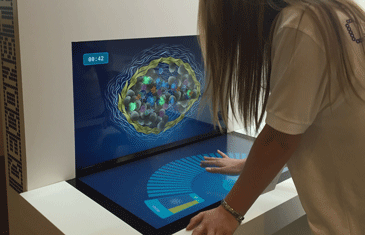
Playing Tumour Takedown at the Stall
It became clear on the first day that there was a lot of interest in the game Tumour Takedown, but not enough devices for visitors to play it on. One of the members of staff on the stand had brought a tablet with them on the first day and we were able to use this as a second device for visitors to play the game. However, this was not available at all times so if we were to do this again, we would take more tablets with us.
It’s definitely always worth planning in case of higher numbers than you expect and having spare resources around just in case, however, if you do then make sure you have the staff to supervise these extra activities!
The gel making activity was fun, colourful and particularly enjoyable for younger visitors. It also acted as a good tool to describe what a 3D gel actually is. However, as the activity was much shorter than the other two we found that visitors would finish this quite quickly then have to wait to participate in the other activities. To avoid this it’s worth having a play with activities yourselves to estimate interaction time and plan follow-up activities to engage visitors for longer if one element of your stall is much shorter than others. These follow-ups can then also potentially be dropped easily, building in flexibility if you need to move a group on.
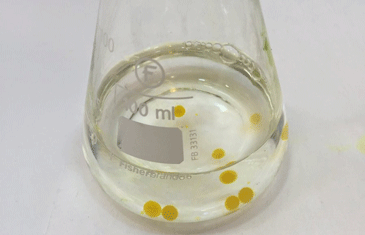
Creating 3D gel balls at the Gel Making Activity
We discovered that the scientists’ knowledge was invaluable and we found that having at least two scientists from the CanBuild team on the stand at all times was really important. Although the non-scientist volunteers were briefed on the content of the stand before the event, there were some really interesting questions from visitors that we weren’t always able to answer. It is also possible that this could be in part solved by a more detailed briefing for the non-scientists.
Having active scientists take part in activities and interact with visitors not only allows them to inform others about their work but it also gives them the opportunity to hear different viewpoints and experiences from visitors which may affect the way they do or think about their own research.
Having such a diverse group of volunteers was useful because it gave us a number of different areas of expertise to draw from. The QMUL scientists were experts in the scientific content of the stand, the Centre of the Cell volunteers were experts in public engagement and the game Tumour Takedown while the CRUK volunteers were experts on cancer treatment and fundraising. As a result of this, throughout the week we were all able to learn skills and knowledge from each other.
The Future
It is hoped that the stand will be used again in the future. As it is built out of a number of small components, it is easy to store and to rebuild. Planning for reusability is important for cost effectiveness. If you’re preparing for one exhibition, the resources or stand could be used again in the future as a cheaper and practiced way of participating in new opportunities as they come up. You could even slightly modify the stand or resources for a different audience.
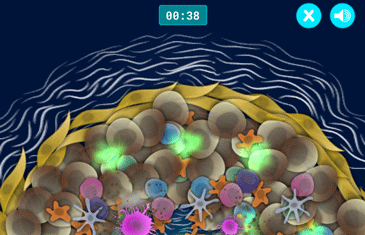
A screenshot of the Tumour Takedown Phone App
There are also two legacies from the stand - Tumour Takedown and a new mini-pod. Tumour Takedown is available to download as an app on the App Store and Google Play and the mini-pod, based on the design of the section of the stand that housed Tumour Takedown, will be able to display a number of Centre of the Cell interactives on the move and will be suitable for use at a variety of events.
Conclusion
Having the chance to be part of the Royal Society Summer Science Exhibition was an unforgettable experience. We were proud and excited to be there representing the work of scientists from QMUL and to be showcasing the Centre of the Cell game Tumour Takedown.
Everyone we talked to was interested and appreciative. People often said that they had previously had no idea about the tumour microenvironment and the other cells involved in a cancer and found the work exciting. Many people also enjoyed playing Tumour Takedown and it was particularly rewarding to see groups of people engaging in the game together and discussing it.
It was also fascinating to be amongst other scientists displaying their research and to see the different ways in which they interacted with the public. Not only did we all learn a lot from working on our own stand but we also learnt a lot from the other contributors at the event.
We would encourage anyone to visit the Royal Society Summer Science Exhibition next year. Whether you’re already interested in science or even if it’s not really your thing, there is something there for everyone.
Written by Rebecca Knowlson and Alex Jenkin,
Learning and Outreach Officers
Centre of the Cell